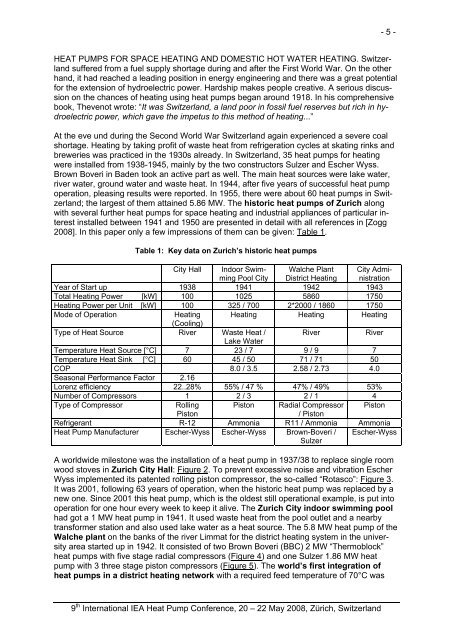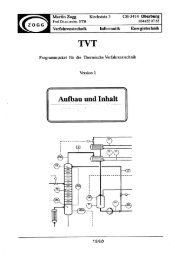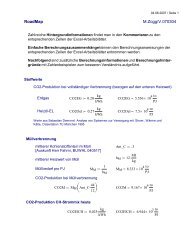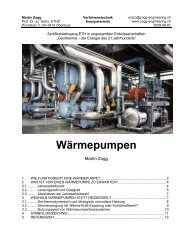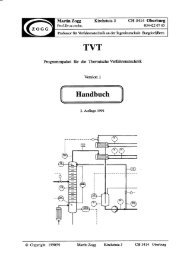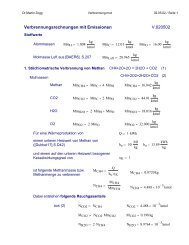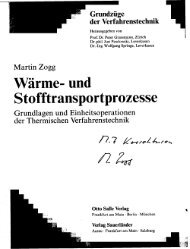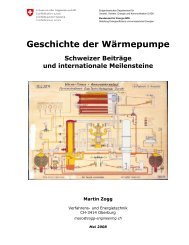TITLE, PLEASE USE 14-pt ARIAL FONT, BOLD ... - of Martin Zogg
TITLE, PLEASE USE 14-pt ARIAL FONT, BOLD ... - of Martin Zogg
TITLE, PLEASE USE 14-pt ARIAL FONT, BOLD ... - of Martin Zogg
Create successful ePaper yourself
Turn your PDF publications into a flip-book with our unique Google optimized e-Paper software.
- 5 -<br />
HEAT PUMPS FOR SPACE HEATING AND DOMESTIC HOT WATER HEATING. Switzerland<br />
suffered from a fuel supply shortage during and after the First World War. On the other<br />
hand, it had reached a leading position in energy engineering and there was a great potential<br />
for the extension <strong>of</strong> hydroelectric power. Hardship makes people creative. A serious discussion<br />
on the chances <strong>of</strong> heating using heat pumps began around 1918. In his comprehensive<br />
book, Thevenot wrote: “It was Switzerland, a land poor in fossil fuel reserves but rich in hydroelectric<br />
power, which gave the impetus to this method <strong>of</strong> heating...”<br />
At the eve und during the Second World War Switzerland again experienced a severe coal<br />
shortage. Heating by taking pr<strong>of</strong>it <strong>of</strong> waste heat from refrigeration cycles at skating rinks and<br />
breweries was practiced in the 1930s already. In Switzerland, 35 heat pumps for heating<br />
were installed from 1938-1945, mainly by the two constructors Sulzer and Escher Wyss.<br />
Brown Boveri in Baden took an active part as well. The main heat sources were lake water,<br />
river water, ground water and waste heat. In 1944, after five years <strong>of</strong> successful heat pump<br />
operation, pleasing results were reported. In 1955, there were about 60 heat pumps in Switzerland;<br />
the largest <strong>of</strong> them attained 5.86 MW. The historic heat pumps <strong>of</strong> Zurich along<br />
with several further heat pumps for space heating and industrial appliances <strong>of</strong> particular interest<br />
installed between 1941 and 1950 are presented in detail with all references in [<strong>Zogg</strong><br />
2008]. In this paper only a few impressions <strong>of</strong> them can be given: Table 1.<br />
Table 1: Key data on Zurich’s historic heat pumps<br />
City Hall Indoor Swim- Walche Plant City Admiming<br />
Pool City District Heating nistration<br />
Year <strong>of</strong> Start up 1938 1941 1942 1943<br />
Total Heating Power [kW] 100 1025 5860 1750<br />
Heating Power per Unit [kW] 100 325 / 700 2*2000 / 1860 1750<br />
Mode <strong>of</strong> Operation Heating<br />
(Cooling)<br />
Heating Heating Heating<br />
Type <strong>of</strong> Heat Source River Waste Heat / River River<br />
Lake Water<br />
Temperature Heat Source [°C] 7 23 / 7 9 / 9 7<br />
Temperature Heat Sink [°C] 60 45 / 50 71 / 71 50<br />
COP 8.0 / 3.5 2.58 / 2.73 4.0<br />
Seasonal Performance Factor 2.16<br />
Lorenz efficiency 22..28% 55% / 47 % 47% / 49% 53%<br />
Number <strong>of</strong> Compressors 1 2 / 3 2 / 1 4<br />
Type <strong>of</strong> Compressor Rolling Piston Radial Compressor Piston<br />
Piston<br />
/ Piston<br />
Refrigerant R-12 Ammonia R11 / Ammonia Ammonia<br />
Heat Pump Manufacturer Escher-Wyss Escher-Wyss Brown-Boveri /<br />
Sulzer<br />
Escher-Wyss<br />
A worldwide milestone was the installation <strong>of</strong> a heat pump in 1937/38 to replace single room<br />
wood stoves in Zurich City Hall: Figure 2. To prevent excessive noise and vibration Escher<br />
Wyss implemented its patented rolling piston compressor, the so-called “Rotasco”: Figure 3.<br />
It was 2001, following 63 years <strong>of</strong> operation, when the historic heat pump was replaced by a<br />
new one. Since 2001 this heat pump, which is the oldest still operational example, is put into<br />
operation for one hour every week to keep it alive. The Zurich City indoor swimming pool<br />
had got a 1 MW heat pump in 1941. It used waste heat from the pool outlet and a nearby<br />
transformer station and also used lake water as a heat source. The 5.8 MW heat pump <strong>of</strong> the<br />
Walche plant on the banks <strong>of</strong> the river Limmat for the district heating system in the university<br />
area started up in 1942. It consisted <strong>of</strong> two Brown Boveri (BBC) 2 MW “Thermoblock”<br />
heat pumps with five stage radial compressors (Figure 4) and one Sulzer 1.86 MW heat<br />
pump with 3 three stage piston compressors (Figure 5). The world’s first integration <strong>of</strong><br />
heat pumps in a district heating network with a required feed temperature <strong>of</strong> 70°C was<br />
9 th International IEA Heat Pump Conference, 20 – 22 May 2008, Zürich, Switzerland


